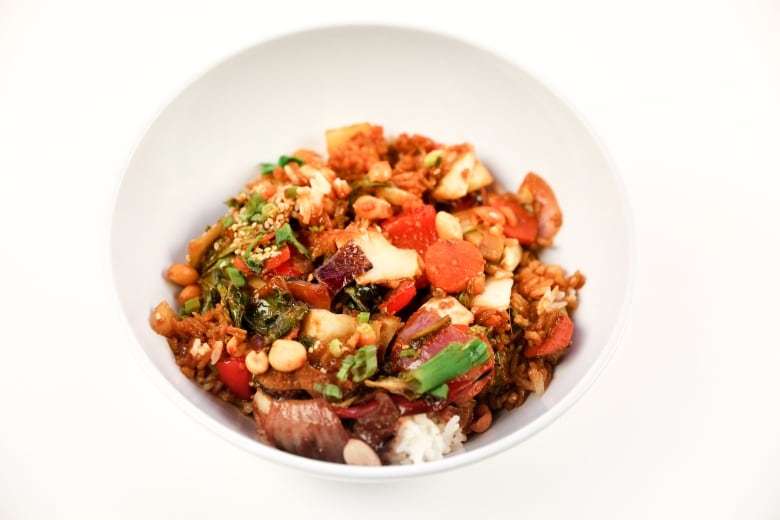You probably wouldn’t load multiple packets of salt into one dish, but that’s the equivalent of how much sodium could be in some of your favourite healthy-sounding restaurant meals.
Thank you for reading this post, don't forget to subscribe!Sodium is found in all kinds of foods long before you pick up a salt shaker; it’s often added to preserve food and enhance taste.
Health Canada recommends the average person consume 1,500 milligrams of sodium per day — and no more than 2,300 milligrams per day, or equivalent to just over one teaspoon of salt. Too much sodium in our diets can lead to high blood pressure, a major risk factor for developing stroke and heart disease.
Most of the sodium in Canadians’ diets comes from highly processed foods, according to Health Canada, and restaurant meals can be a major source, too.
To analyze how much sodium might be hiding in seemingly healthy-sounding meals, Marketplace reviewed the sodium content posted online for items at popular sit-down chain restaurants — and found some dishes that even shocked dietary experts.
“People will often say, ‘Oh, you know, don’t add any salt to my meal,’ thinking that’s going to reduce the sodium,” said registered dietitian Samantha Chabior.
“But [the] majority has already been added in — in the seasonings, the marinades, all the foods that have been prepared ahead of time — before you even get to the restaurant.”
To help grocery shoppers make informed decisions at a glance, Health Canada is introducing front-of-package warning labels on prepackaged foods, including high sodium warnings, which Canadians will be seeing by 2026. But those same nutritional-labelling requirements won’t apply to restaurant menus.

“It is very challenging,” said Chabior, noting that even as a dietitian she can be surprised with the amount of sodium found in some restaurant meals. “Sometimes even between two different restaurants, the same meal can be vastly different in terms of sodium content.”
“If the entire population is eating too much salt or sodium … more people will develop high blood pressure, more people will develop stroke and heart disease and [we’ll] have this excess burden on the health-care system,” said Dr. Paul Oh, medical director of the University Health Network’s Cardiovascular Prevention and Rehabilitation Program in Toronto.
More than the daily limit in 1 dish
While sodium information can be found on the websites of many restaurant chains, it’s not readily available on menus.
To check the sodium content of some popular meals, Marketplace looked up the nutritional information posted online by the restaurants for healthy-sounding dishes, finding that some exceed the recommended daily limit in a single dish.
For example, the branding of the Mediterranean bowl at Joey Restaurants may have what some dietary experts call a health halo — a term for something that sounds healthier than it may actually be.
“People would see the word Mediterranean and think, ‘Oh, there’s heart-health benefits to eating a Mediterranean diet,’ so this would be a great option,” said Chabior. “And of course, the Mediterranean diet itself does have great heart health benefits.”
There are some great fibre-rich options in the offering, like chickpeas, vegetables and some chicken, she said, “but unfortunately, there are some sneaky sources of sodium in there.”
The dish is listed as having 2,530 milligrams of sodium.

“That’s one dish — your entire upper limit,” said Oh. For some of the patients he works with, he noted, “this is probably twice as much as they should have for the entire day.”
“Whenever you see the word marinade, smoked, pickled, or seasoning, you want to think sodium,” added Chabior.
If you’re looking to shrink your sodium, she suggests another option on the menu at Joey: the crispy tofu bowl, with 1,330 milligrams of sodium.
Marketplace asked Joey Restaurants for more information about where the sodium content in the Mediterranean bowl comes from, but they didn’t respond.
At Earls Kitchen + Bar, Marketplace ordered the vegan Hunan kung pao dish on the plant-based section of the menu. The restaurant chain initially told Marketplace the dish had 3,110 milligrams of sodium.
After Marketplace contacted Earls, the chain said it made updates to the vegan Hunan kung pao and lowered the sodium to 2,850 milligrams.
“People associate vegan foods with having nutritional benefits, and the vegan diet is a great diet choice,” said Chabior. “But oftentimes, we do need to be careful, because there can still be a lot of sodium in the dish.”

For a lower-sodium swap at Earls, Chabior suggested something that’s still plant-based: the vegan spring greens and grains salad, listed as having 600 milligrams of sodium.
Earls also told Marketplace it provides “a variety of menu options … from healthy to more indulgent” and their complete nutritional information is easily accessible on their website “so that guests can make informed choices.”
At Kelseys Original Roadhouse, Marketplace ordered the chicken fajitas. The restaurant’s website says that menu item has 4,340 milligrams of sodium — almost double the daily recommended limit in one dish, and the highest amount of sodium out of all the menu items Marketplace purchased.
“I think this is probably too much [sodium] for anybody — with a heart condition, with high blood pressure or even without any conditions whatsoever,” said Oh.
“I think a lot of times, people would be choosing this type of dish because they see lots of chicken, they see vegetables.… But unfortunately there are quite a few sources of sodium in this particular dish,” Chabior said.

The dish includes cheese and what looks like seasoning on the chicken, which could be contributors of sodium. Chabior also noted it comes with five tortillas.
“Each one of those are going to be a sneaky source of sodium. Just one tortilla can have 200 to 300 milligrams of sodium in it.”
A lower sodium alternative at Kelseys, she said, would be to build your own burger, with a grilled chicken breast and a side of steamed vegetables. “You might be surprised that that’s actually going to be a lower sodium choice — a burger. But it comes in at 1,166 milligrams of sodium.”
Marketplace contacted Kelseys to ask them more about the sodium content in the chicken fajitas, but they didn’t respond.
Dessert anyone?
Higher sodium options aren’t just limited to entrees. Consider the birthday cake at Jack Astor’s Bar & Grill, which is listed online as having 956 milligrams of sodium.
“This one’s a real surprise,” said Oh.
The restaurant says the dessert is intended to serve two people, which would bring it to 478 milligrams of sodium per serving, or about 20 per cent of the daily recommended limit.

“People don’t realize that there’s sodium in things like baking soda and baking powder,” said Chabior. “In one teaspoon of baking soda, we have almost 1,300 milligrams of sodium.”
If it’s your birthday, go ahead and enjoy yourself, Chabior suggests. But if you are looking for a lower sodium treat, you can order what the restaurant calls the “world’s most ridiculously small brownie,” with only 67 milligrams of sodium.
Warnings required on menus in parts of the U.S., not Canada
While Canadians will eventually see new high-sodium warnings on prepackaged foods, some public health experts say restaurant menus have been ignored when it comes to similar requirements.
High sodium foods can be found across restaurant chains in Canada, according to a recent University of Toronto study, which reviewed nutritional information and nutritional quality. The researchers shared unpublished data with Marketplace from that study, showing that entree dishes at sit-down chain restaurants contained, on average, 1,462 milligrams of sodium.
Watch Marketplace’s full investigation:

The high sodium content of some popular restaurant meals
Marketplace reveals how much sodium is in some popular restaurant meals and shares how consumers can avoid getting caught in a sodium trap.
“For all the effort going on to lower sodium in foods, there is very little improvement going on in restaurants. Some of these food categories just have tremendous amounts of sodium,” said Mary L’Abbé, one of the study’s authors and an expert in public health nutrition.
“I think that symbol could be just as easily on restaurant food. I don’t think there is any valid scientific reason not to do that.”
There has been a push for greater transparency on menus elsewhere.
New York City was the first U.S. city to require sit-down chain restaurants with more than 15 locations to put a warning icon on menu items with 2,300 milligrams of sodium or more. The policy came into effect in 2016 despite an initial legal challenge by the National Restaurant Association.

“When you walk into a chain restaurant, you may not be able to tell exactly how much sodium is in the product; for example, you may have two very similar-sounding items … they may have dramatically different amounts of sodium,” said Amaka Anekwe, the director of strategic nutrition initiatives at the New York City Health Department.

Preliminary evidence gathered by the city’s Health Department seems to show the warning icon is leading consumers to choose lower sodium options at sit-down restaurant chains, Anekwe said.
“It’s impossible to know, just by looking, how much sodium is in an item. So an icon does that for you,” she said.
When Marketplace asked Health Canada why restaurants are not included under the new labelling requirements, the department said “the front-of-package (FOP) nutrition symbol is intended to complement the nutrition-labelling information.” There are no federal requirements for providing nutrition information on foods that are not prepackaged, such as menu items.
Avoid getting caught in the sodium trap
Both Chabior and Oh say more information for consumers on menus would be helpful. Meantime, they suggest diners review online menus before heading to a restaurant, to know how much sodium you might be getting.
And both say don’t be afraid to eat out or to treat yourself now and then.
“I think a great approach is thinking about the 80/20 principle,” said Chabior. “Eighty per cent of the time we try and follow this lower sodium diet: we make nutritious choices, we cook at home more often, from minimally processed ingredients.
“That will leave room for the additional 20 per cent, where we have some flexibility in our diet so that we can go out on occasion and enjoy a meal with friends.”
